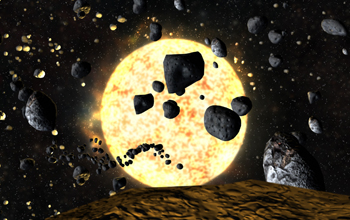Multimedia Gallery
Still from CyGaME Project instructional video game 'Selene' (Image 3)
In this screenshot from the Cyberlearning through Game-based, Metaphor Enhanced Learning Objects (CyGaME) project game "Selene," after a player successfully accretes their proto moon, the heat of collisions melts it and the player's early moon totally melts and forms a magma ocean, which differentiates into layers according to density and gravity. Solar system debris continue to bombard the moon's surface. "Selene" models the giant impact theory -- which states that the moon was formed out of debris left over from an indirect collision between Earth and an astronomical body the size of Mars, approximately 4.5 billion years ago -- and player inquiry discovers and applies the physics through which debris from the collision accreted as the Earth's proto moon.
More about this image
Players of the CyGaME Project's instructional video game "Selene," a lunar science game developed by the Center for Educational Technologies® (CET) and supported by a grant from the National Science Foundation (NSF), discover and apply fundamental geological processes such as collisional accretion.
CET created "Selene" to answer the question: Would young people learn science better if it were packaged in a video game? Named after the Greek lunar goddess, "Selene" challenges players to learn the major geologic processes scientists believe formed the modern moon. Players construct their own moon and then add impact craters and lava. It provides students with the opportunity to learn about lunar geology, while helping researchers study some key video game design principles.
The CyGaME approach employs cognitive science, informatics science and analysis methods to help game designers have more control over what games do; that is, to help players learn by doing, discovering and inquiring.
"Selene" received two honorable mention awards in the games and apps category of the 2012 International Science & Engineering Visualization Challenge, sponsored by NSF and Science magazine.
Further information about "Selene" is available Here. [Research supported by NSF grant DRL 08-14512.] (Date of Image: October 2009) [Image 3 of 3 related images. Back to Image 1.]
Credit: Debbie Denise Reese, CYGaMEs Project, Center for Educational Technologies, Wheeling Jesuit University
See other images like this on your iPhone or iPad download NSF Science Zone on the Apple App Store.
Images and other media in the National Science Foundation Multimedia Gallery are available for use in print and electronic material by NSF employees, members of the media, university staff, teachers and the general public. All media in the gallery are intended for personal, educational and nonprofit/non-commercial use only.
Images credited to the National Science Foundation, a federal agency, are in the public domain. The images were created by employees of the United States Government as part of their official duties or prepared by contractors as "works for hire" for NSF. You may freely use NSF-credited images and, at your discretion, credit NSF with a "Courtesy: National Science Foundation" notation.
Additional information about general usage can be found in Conditions.
Also Available:
Download the high-resolution TIF version of the image. (12.9 MB)
Use your mouse to right-click (Mac users may need to Ctrl-click) the link above and choose the option that will save the file or target to your computer.



